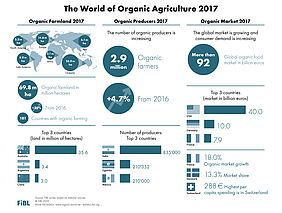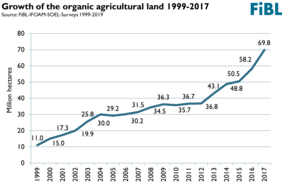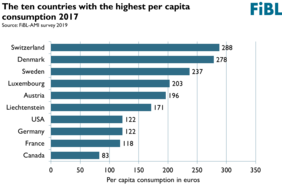(Frick/Nuremberg, February 13, 2019) The year 2017 was another record year for global organic agriculture. According to the latest FiBL survey on organic agriculture worldwide, the organic farmland increased substantially, and the number of organic producers and organic retail sales also continued to grow, reaching another all-time high, as shown by the data from 181 countries (data as of the end 2017). The 20th edition of the study "The World of Organic Agriculture" published by FiBL and IFOAM – Organics International shows a continuation of the positive trend seen in the past years. The annual survey on organic agriculture worldwide is supported by the Swiss State Secretariat for Economic Affairs (SECO), the International Trade Centre (ITC), the Sustainability Fund of Coop Switzerland, and NürnbergMesse, the organizers of the BIOFACH fair.
The global organic market continues to grow worldwide and has reached 97 billion US dollars
The market research company Ecovia Intelligence estimates that the global market for organic food reached 97 billion US dollars in 2017 (approx. 90 billion euros). The United States is the leading market with 40 billion euros, followed by Germany (10 billion euros), France (7.9 billion euros), and China (7.6 billion euros). In 2017, many major markets continued to show double-digit growth rates, and the French organic market grew by 18 percent. The Swiss spent the most on organic food (288 Euros per capita in 2017). Denmark had the highest organic market share (13.3 percent of the total food market).
Almost three million producers worldwide
In 2017, 2.9 million organic producers were reported, which is 5 percent more than in 2016. India continues to be the country with the highest number of producers (835’200), followed by Uganda (210’352), and Mexico (210’000).
Record growth of the organic farmland: 20 percent increase
A total of 69.8 million hectares were organically managed at the end of 2017, representing a growth of 20 percent or 11.7 million hectares over 2016, the largest growth ever recorded. Australia has the largest organic agricultural area (35.6 million hectares), followed by Argentina (3.4 million hectares), and China (3 million hectares). Due to the large area increase in Australia, half of the global organic agricultural land is now in Oceania (35.9 million hectares). Europe has the second largest area (21 percent; 14.6 million hectares), followed by Latin America (11.5 percent; 8 million hectares). The organic area increased in all continents.
Ten percent or more of the farmland is organic in fourteen countries
Globally, 1.4 percent of the farmland is organic. However, many countries have far higher shares. The countries with the largest organic share of their total farmland are Liechtenstein (37.9 percent), Samoa (37.6 percent), and Austria (24 percent). In fourteen countries, 10 percent or more of all agricultural land is organic.
Global organic statistics show the contribution of organic agriculture to the Sustainable Development Goals
According to Dr. Monica Rubiolo from SECO and Joseph Wozniak from ITC "global data on organic production and markets are of high relevance for policy makers and contribute to understanding the importance of organic farming in the different countries."
"This publication shows our ongoing engagement with transparency in the organic sector" say Professor Urs Niggli, FiBL director, and Louise Luttikholt, IFOAM – Organics International Executive Director. And they add "This publication also demonstrates the contribution of organic agriculture to the Sustainable Development Goals. Overall, the yearbook shows the potential organic farming has to contribute to a sustainable future!"
More information
Order book and download
The printed version of "The World of Organic Agriculture" (30 Euros + postage; affiliates of IFOAM – Organics International: 20 Euros) can be ordered and downloaded at the FiBL shop (order number 2020) and the IFOAM shop.
"The World of Organic Agriculture" as well as graphs and infographics can be downloaded at
- fibl.org: "The World of Organic Agriculture 2019" in the FiBL shop
- ifoam.bio: "The World of Organic Agriculture 2019" in the IFOAM shop
- organic-world.net: Download "The World of Organic Agriculture 2019" as well as graphs and infographics
Online database
Tables with more details on crops, markets, and international trade, as well as explanations can be found on FiBL’s new statistics website.
- fibl.org: FiBL statistics website
Contacts
- Dr. Helga Willer, FiBL, Ackerstrasse 113, 5070 Frick, Switzerland
- Louise Luttikholt, IFOAM – Organics International, Charles-de-Gaulle-Strasse 5, 53113 Bonn, Germany
Phone +49 (0)160 8041557, Fax +49 (0)228 9265099, l.luttikholt(at)ifoam.bio, www.ifoam.bio
Programme of the session "The World of Organic Agriculture – Statistics and Emerging Trends"
Wednesday, February 13, 2019, 4:00 to 4:45 pm, Hall Shanghai (NCC East), NürnbergMesse, Nürnberg
- Louise Luttikholt, IFOAM – Organics International, Moderator
- Dr. Monica Rubiolo, Swiss State Secretariat for Economic Affairs (SECO), Switzerland
- Dr. Helga Willer, FiBL: The adventure of 20 years of data collection on organic agriculture
- Julia Lernoud, FiBL: Latest data on organic agriculture worldwide
- Beate Huber, FiBL: Standards and regulations
- Amarjit Sahota, Ecovia Intelligence, UK: The global market for organic food
More information at
- fibl.org: FiBL BIOFACH website
Supporters
- Swiss State Secretariat for Economic Affairs (SECO)
- International Trade Centre (ITC)
- Coop Sustainability Fund, Coop Switzerland
- NürnbergMesse, the organizers of the BIOFACH fair
The views expressed in this press release can in no way be taken to reflect the official opinions of SECO, ITC, or NürnbergMesse.
Reference
Helga Willer and Julia Lernoud (Eds.) (2019): The World of Organic Agriculture. Statistics and Emerging Trends 2019. Research Institute of Organic Agriculture (FiBL), Frick and IFOAM – Organics International, Bonn. Available at www.organic-world.net/yearbook/yearbook-2019.html
Download
Media kit including this media release and further data and graphs
Media kit including this media release and further data and graphs






